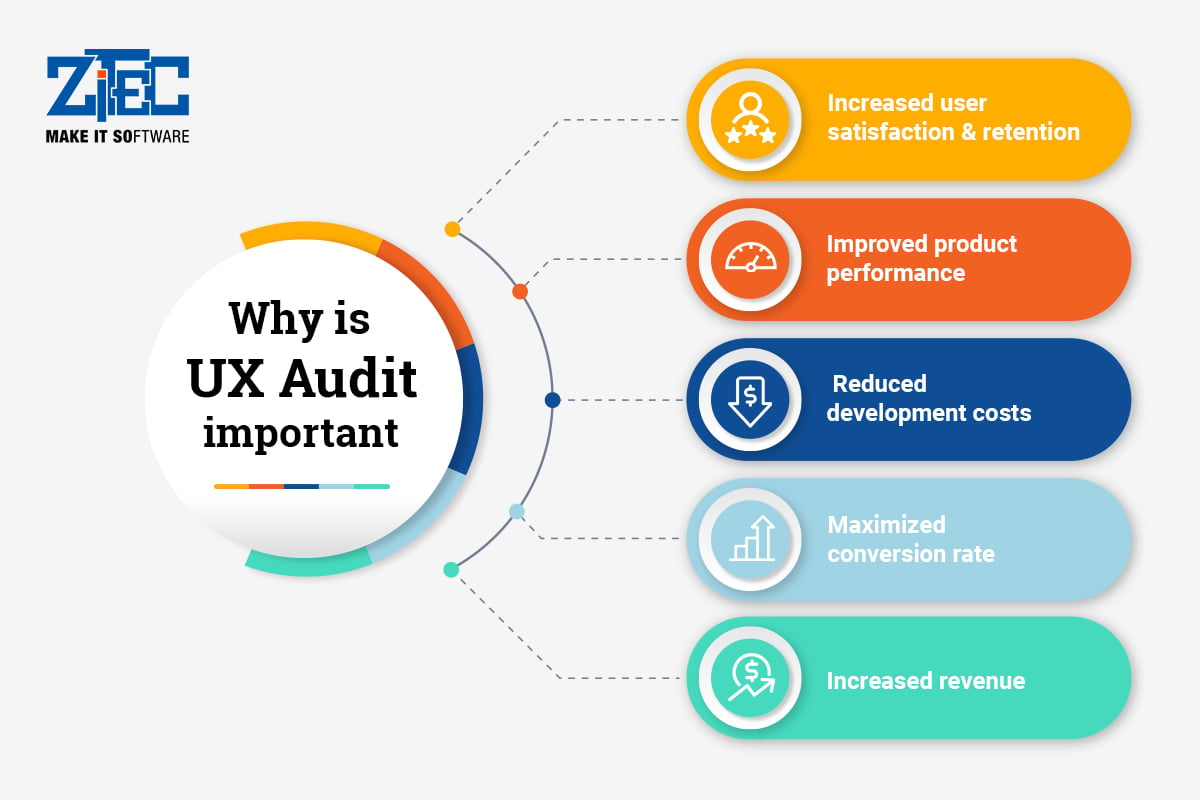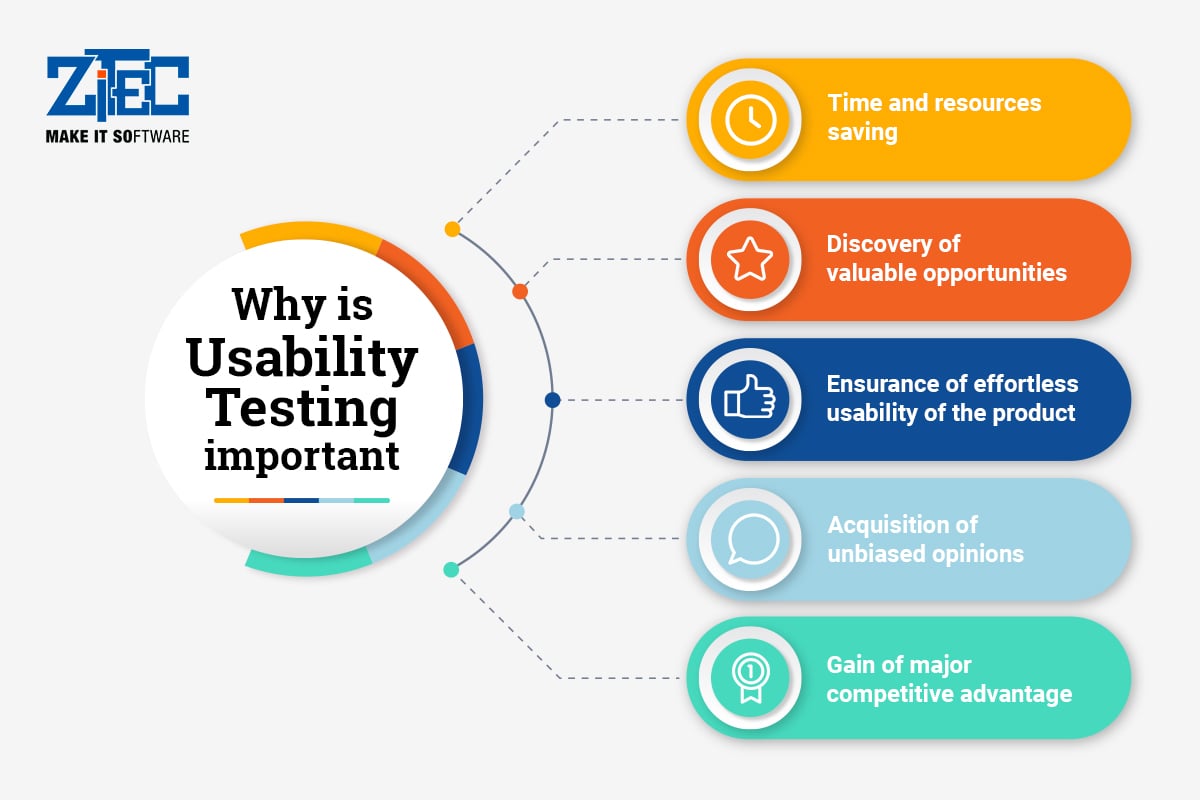Every digital product, whether it might be a website, mobile application, web application, landing page, or software, has UX design at its core. Users expect a fluid and seamless user experience when they use your website or mobile app. The likelihood is that consumers will just give up and visit one of your competitors if they have trouble finding the information they want while dealing with your mobile app or website. It's crucial to understand user behavior and why consumers leave your app or website. The reason is to improve the functionality and quality of your digital product.
Both UX audits and Usability Testing are useful in this situation. But Alex Axon, Zitec’s Chief Experience Officer, will disclose in the following lines what each of these methods solves specifically. By the end of this text you'll know when and how to best employ each of the methods.
First things first - let’s refresh on what we already know about the UX Audit.
What is a UX Audit?
A UX Audit, or a UX Expert Review, is a usability and user experience inspection method. During this process, a UX Specialist examines a system (such as a website or application) in order to identify any usability problems.
The term UX Audit encompasses several methods of inspection, including Heuristic Evaluation or Cognitive Walkthrough. In the Heuristic Evaluation, experts evaluate the user interface of a product against a set of “heuristics” or recognized usability principles. The Cognitive Walkthrough technique evaluates issues in interactive systems. More precisely, the reviewers walk through each step of a task. They do this to discover what aspects of the interface could be challenging for the user.
What can a UX Audit tell you?
Sometimes, certain issues make users abandon their buying journey. But a UX Audit will help you detect these problematic areas. To go further in depth, examine an online eCommerce store. Let’s take for example a concrete situation encountered by Brico Dépôt’s customers. The inconvenience was caused by the search function, as it did not provide any suggestions nor help for the searched product. A UX Audit specialist would advise Brico Dépôt to implement a system that helps the user and provides search suggestions. These can include similar searches by other users, depiction of popular searches, products or categories.
Another case would be the Authentication section in the ASE’s homepage. The items displayed there are not properly aligned by the rule of proximity. According to the “UX rules”, not only these items should be aligned and the page should have better spacing style, but the titles on the page should be closer to the corresponding icon, instead of being positioned to other icons.
There are other several problems that can lead to a negative experience for the customer. One, the lack of the necessary information about the product description or its delivery. Two, the limited payment options or, simply, the payment method is too rigorous. The list can go on from too much time spent on a page to load, to lots of minor details to complete before the checkout.
Yet, the result is the same. Users will most likely disregard the buying initiative, which leads to a high shopping cart abandonment rate for your site. Enough for now? Then a UX Audit can reveal all these user challenges. Moreover, the benefit here is that this type of audit can be conducted at all stages in the design cycle.
The business value of a UX Audit
If “benefits” is a word that stirs your attention, then you should keep reading. Product design owners and development teams are usually concerned with creating useful and user-friendly digital products that will benefit the customer. To accomplish this, they firstly perform a UX design audit to understand the root cause of website issues. For example, high bounce, churn or drop rates, copy and navigation ambiguity, among others.
Once these are uncovered and addressed, a UX Audit will help you reach the following results:
✔️ Increased user satisfaction
✔️ Improved product performance
✔️ Reduced development costs
✔️ Maximized conversion rate
✔️ Increased revenue
✔️ Increased user retention
The outcome of this audit method is a website with improved functionalities. In return, this levels up the customer’s satisfaction, eliminating confusions or frustrations. The snowball effect is that from a business’ perspective, having a satisfied user means better chances to higher conversion rates and better sales. For instance, checking Mobino’s homepage on mobile devices, the titles called “Products of the moment” and “Daily Offer” appear like two buttons that require to be accessed. However, these are not actionable, which might cause customer’s dissatisfaction. Yet, if this section would have proper title formats instead of buttons, don’t you think the user’s experience would be less chaotic?

Mirroring all the above, you will further analyze the perspective of a Usability Testing method.
What is Usability Testing?
Being one of the most important steps in the product development process, Usability Testing can help you discover design and user experience problems before your customers do.
When talking about the usability of an application, take into account one important aspect: its user-friendliness. Specifically, the extent to which a customer can use a product without facing obstacles, doubts, or questions that might create frustrations on the user’s side.
What can a Usability Testing Audit tell you?
During this evaluation method, a product or service is tested, while the activities of its representative users are inspected. To be exact, participants will try to complete certain tasks, and observers will watch, listen and take notes. This test aims to identify any usability problems, collect qualitative and quantitative data and lastly, to determine the participant's level of satisfaction with the product.
Worth mentioning is that user feedback is a significant aspect for any business. Having an overview of the needs and requirements of your target audience, you can improve your product or service accordingly. Usability testing constitutes one of the prime ways to obtain user’s feedback because you directly observe how users interact with what you offer. Let’s take for example some input received by our team from a user during a Usability testing audit, performed for a mobile app, for a medical clinic:
“I would have loved to see on the site a more engaging and visually appealing way to be able to easily make any medical appointments. To achieve this, users currently engage in 4 steps, but, to me personally, not all of them are important.”
During a usability test, you can:
✔️ Learn if the participants are successfully completing specific tasks
✔️ Identify the period of time necessary to complete specific tasks
✔️ Discover your participants’ level of satisfaction with your product
✔️ Identify the required changes to streamline user performance
✔️ Analyze if the performance meets the business objectives
The business value of Usability Testing
The bottom line is that the more information you gather regarding your users’ engagement, the more possibilities to improve your product, hence to obtain an optimal user experience. For instance, amid the usability tests that we conducted on Brico Dépôt’s website, alongside its users, we discovered that customers expected real-time suggestions when searching for a product. More precisely, in the search bar, users wanted to see search phrases related to their needs and best-selling products.
The biggest benefits of usability testing in app development are as follows:
✔️ Time and resources saving
✔️ Discovery of valuable opportunities
✔️ Ensurance of effortless usability of the product
✔️ Acquisition of unbiased opinions
✔️ Gain of major competitive advantage

UX Audit vs Usability Testing
You have noticed so far that both methods are extremely valuable and help uncover UX and usability issues. But what about the differences between the two and when is it best to use one method and not the other?
The issues identified by a UX specialist are less likely to be observed in a Usability Testing study because mostly they refer to best design practices:
✔️ Inconsistencies in font-usage throughout the interface
✔️ No visual differences between primary and secondary calls to action
✔️ The lack of visual feedback on various interactions
✔️ Colors that don’t follow brand guidelines
✔️ Inappropriate loading times of certain pages
✔️ Bad placement of error messages, prompts, cues
✔️ Confusing micro-copy
✔️ Inconsistent navigation
A UX Audit should be done before a Usability Testing, as it will unveil the majority usability issues. Of course, although a UX Audit can uncover some of the aspects observed in a Usability Testing session, a UX specialist cannot see all the issues that real users encounter. Instead, a Usability Testing study can.
All in all, an expert review works hand in hand with an upcoming usability study. Take for example the process of evaluating a website design. This will identify the areas of concern that can be addressed in the study, as well as more obvious issues that should be fixed before usability testing. Once these are taken out of the equation, the study can further focus on unpredictable findings. This is why if you combine a UX Audit with a Usability Testing, you can obtain the best overall design.
Do you want to find out how to grow your business and create the appropriate user experience? We can help you build compelling websites and apps, while offering your customers flawless user journeys. Contact us at contact@zitec.com or find Alex Axon via his LinkedIn profile.




